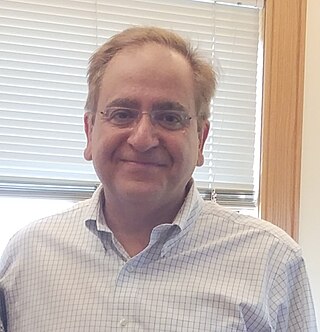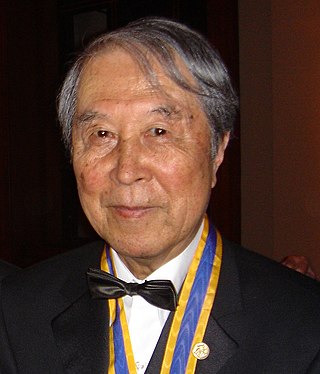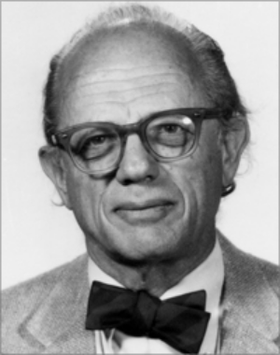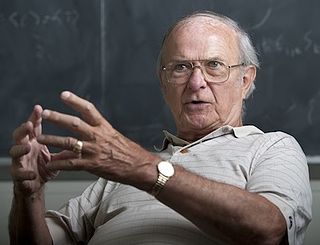Related Research Articles

Steven Weinberg was an American theoretical physicist and Nobel laureate in physics for his contributions with Abdus Salam and Sheldon Glashow to the unification of the weak force and electromagnetic interaction between elementary particles.

Frank Anthony Wilczek is an American theoretical physicist, mathematician and Nobel laureate. He is the Herman Feshbach Professor of Physics at the Massachusetts Institute of Technology (MIT), Founding Director of T. D. Lee Institute and Chief Scientist at the Wilczek Quantum Center, Shanghai Jiao Tong University (SJTU), distinguished professor at Arizona State University (ASU) and full professor at Stockholm University.

Cumrun Vafa is an Iranian-American theoretical physicist and the Hollis Professor of Mathematicks and Natural Philosophy at Harvard University.

David Jonathan Gross is an American theoretical physicist and string theorist. Along with Frank Wilczek and David Politzer, he was awarded the 2004 Nobel Prize in Physics for their discovery of asymptotic freedom. Gross is the Chancellor's Chair Professor of Theoretical Physics at the Kavli Institute for Theoretical Physics (KITP) of the University of California, Santa Barbara (UCSB), and was formerly the KITP director and holder of their Frederick W. Gluck Chair in Theoretical Physics. He is also a faculty member in the UCSB Physics Department and is affiliated with the Institute for Quantum Studies at Chapman University in California. He is a foreign member of the Chinese Academy of Sciences.

The Institute for Nuclear Studies was founded September 1945 as part of the University of Chicago with Samuel King Allison as director. On November 20, 1955, it was renamed The Enrico Fermi Institute for Nuclear Studies. The name was shortened to The Enrico Fermi Institute (EFI) in January 1968.

Yoichiro Nambu was a Japanese-American physicist and professor at the University of Chicago.
Jeffrey Goldstone is a British theoretical physicist and an emeritus physics faculty member at the MIT Center for Theoretical Physics.

The MIT Department of Physics has over 120 faculty members, is often cited as the largest physics department in the United States, and hosts top-ranked programs. It offers the SB, SM, PhD, and ScD degrees. Fourteen alumni of the department and nine current or former faculty members have won the Nobel Prize in Physics.
The Stanford Institute for Theoretical Physics (SITP) is a research institute within the Physics Department at Stanford University. Led by 16 physics faculty members, the institute conducts research in high energy and condensed matter theoretical physics.

Herman Feshbach was an American physicist. He was an Institute Professor Emeritus of physics at MIT. Feshbach is best known for Feshbach resonance and for writing, with Philip M. Morse, Methods of Theoretical Physics.

Giorgio Parisi is an Italian theoretical physicist, whose research has focused on quantum field theory, statistical mechanics and complex systems. His best known contributions are the QCD evolution equations for parton densities, obtained with Guido Altarelli, known as the Altarelli–Parisi or DGLAP equations, the exact solution of the Sherrington–Kirkpatrick model of spin glasses, the Kardar–Parisi–Zhang equation describing dynamic scaling of growing interfaces, and the study of whirling flocks of birds. He was awarded the 2021 Nobel Prize in Physics jointly with Klaus Hasselmann and Syukuro Manabe for groundbreaking contributions to theory of complex systems, in particular "for the discovery of the interplay of disorder and fluctuations in physical systems from atomic to planetary scales".

François, Baron Englert is a Belgian theoretical physicist and 2013 Nobel Prize laureate.

Carl Richard Hagen is a professor of particle physics at the University of Rochester. He is most noted for his contributions to the Standard Model and Symmetry breaking as well as the 1964 co-discovery of the Higgs mechanism and Higgs boson with Gerald Guralnik and Tom Kibble (GHK). As part of Physical Review Letters 50th anniversary celebration, the journal recognized this discovery as one of the milestone papers in PRL history. While widely considered to have authored the most complete of the early papers on the Higgs theory, GHK were controversially not included in the 2013 Nobel Prize in Physics.
The C. N. Yang Institute of Theoretical Physics (YITP) is a research center at Stony Brook University. In 1965, it was the vision of then University President J.S. Toll and Physics Department chair T.A. Pond to create an institute for theoretical physics and invite the famous physicist Chen Ning Yang from Institute for Advanced Study to serve as its director with the Albert Einstein Professorship of Physics. While the center is often referred to as "YITP", this can be confusing as YITP also stands for the Yukawa Institute for Theoretical Physics in Japan.
The Santa Cruz Institute for Particle Physics (SCIPP) is an organized research unit within the University of California system focused on theoretical and experimental high-energy physics and astrophysics.
The Herman Feshbach Prize in Theoretical Nuclear Physics is a prize awarded annually by the American Physical Society to recognize and encourage outstanding achievements in theoretical nuclear physics. The $10,000 prize is in honor of Herman Feshbach of MIT. The prize, inaugurated in 2014, is awarded to one person or is shared among two to three persons when all of the recipients are credited with the same accomplishment.
The Berkeley Center for Theoretical Physics (BCTP) is a research center for theoretical particle physics, cosmology, string theory and quantum gravity at the University of California at Berkeley.
The Maryland Center for Fundamental Physics (MCFP) is a research institute at the University of Maryland, College Park focused on theoretical physics.
Leonardo Senatore is an Italian theoretical physicist and professor at the Stanford Institute for Theoretical Physics, the Kavli Institute for Particle Astrophysics and Cosmology, and SLAC. He was recently appointed professor at ETH Zurich.
References
- ↑ "Center for Theoretical Physics | Laboratory for Nuclear Science".
- ↑ "MIT Department of Physics". web.mit.edu. Retrieved 2019-12-30.
- ↑ "MIT CTP at 50" (PDF).
- ↑ "CTP at 50 Program" (PDF).
- ↑ "Breakthrough Prize – Winners Of The 2021 Breakthrough Prizes In Life Sciences, Fundamental Physics And Mathematics Announced". breakthroughprize.org. Retrieved 2020-10-06.
- ↑ "Breakthrough Prize – Fundamental Physics Breakthrough Prize Laureates – Daniel Harlow". breakthroughprize.org. Retrieved 2019-12-31.
- ↑ "Kerson Huang, professor emeritus of physics, dies at 88". MIT News. Retrieved 2019-12-31.
- ↑ "2016 Herman Feshbach Prize in Theoretical Nuclear Physics Recipient". American Physical Society. 2016.